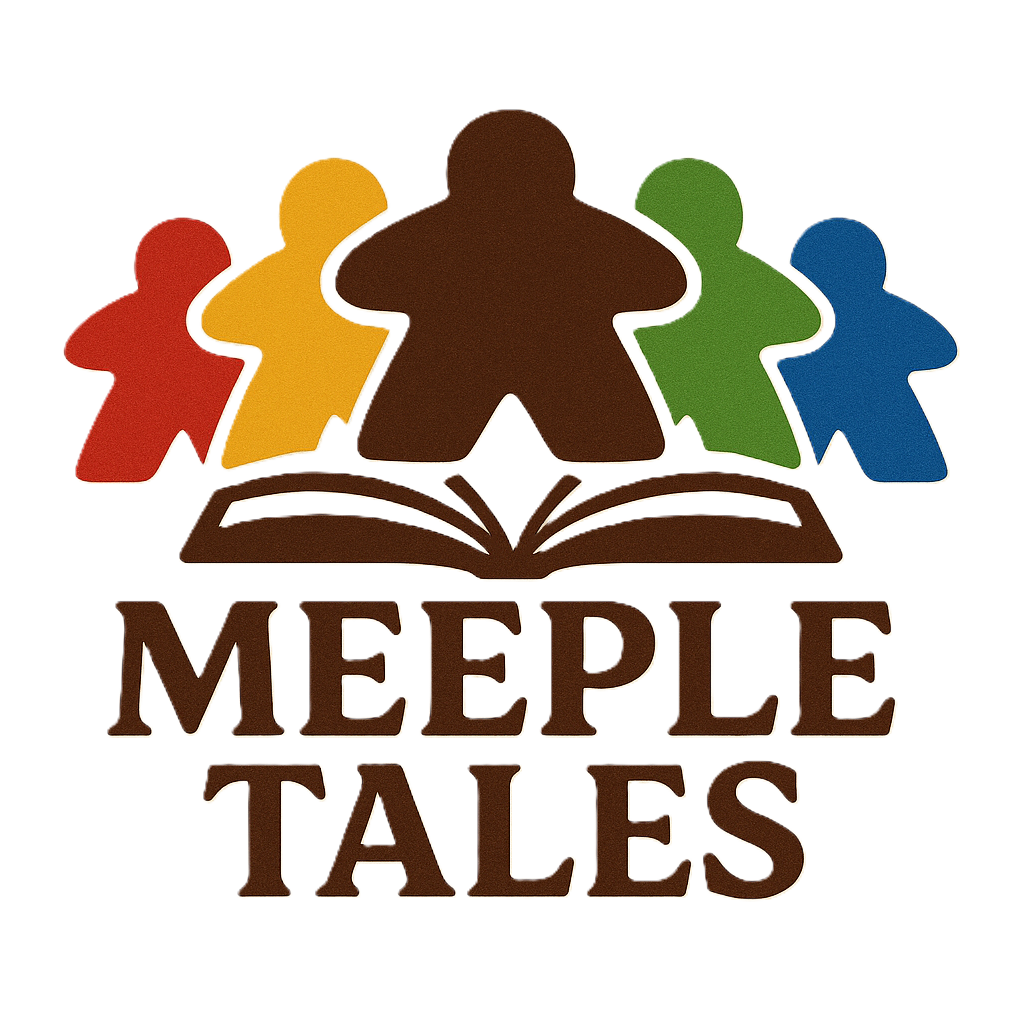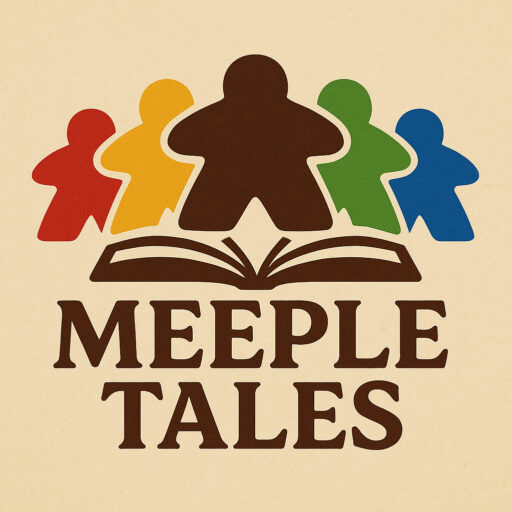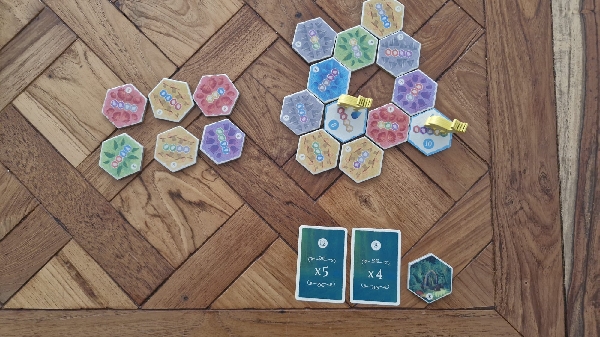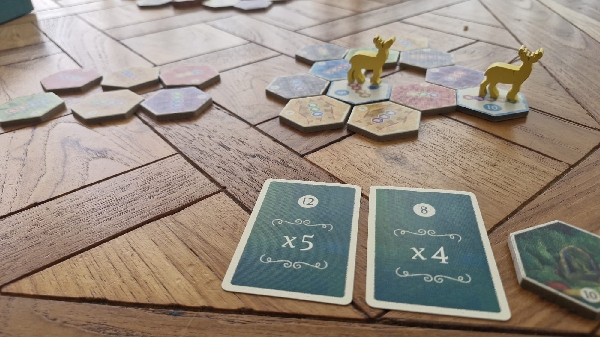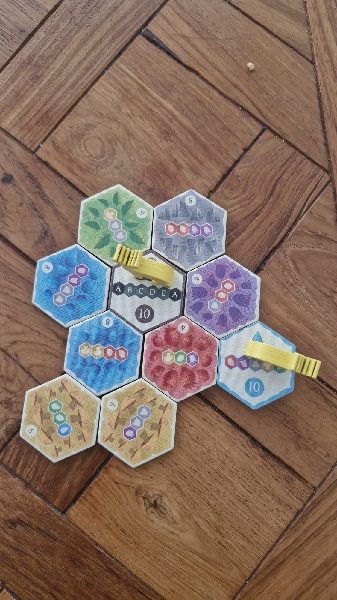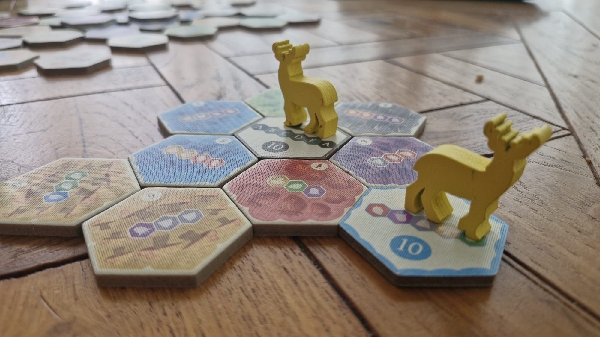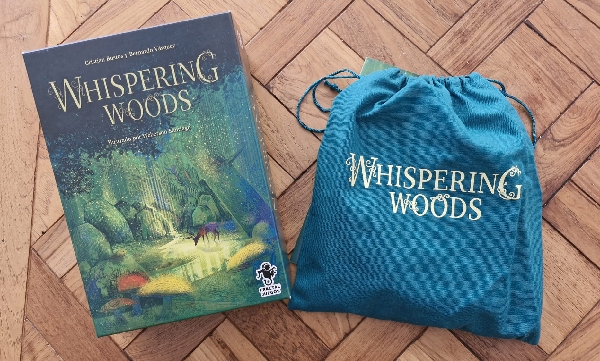Aantal spelers: 1-4
Speelduur: 25-40 minuten
Leeftijd: Vanaf 8 jaar
Auteur: Cristian Bustos, Bernardo Vásquez
Uitgever: Fractal Juegos
Jaar: 2024
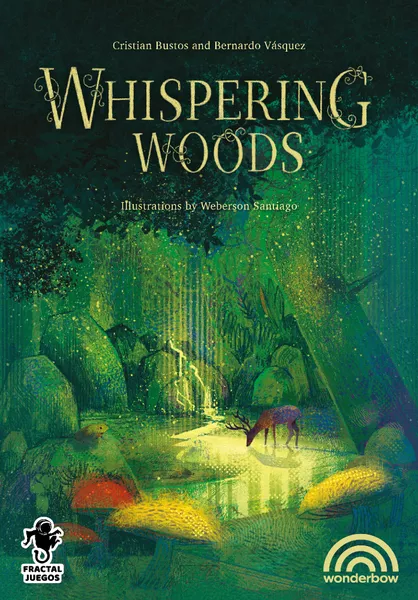

Dit is een herpublicatie van een review die ik eerder schreef voor bordspelwereld.nl
Ik ben een sucker voor natuurspelletjes. Gooi boom, bos, park of de naam van een of ander schattig diertje in de titel en mijn interesse is op zijn minst gewekt. Dan loop je natuurlijk ook wel eens het risico om de deksel op je neus te krijgen. Want niet elk spel met enige vorm van flora of fauna in de titel is qua thematiek ook de letterlijke vertaling daarvan. Laat je ook bij Whispering Woods niet misleiden door de mooie groene doos of de ietwat mystieke titel. We hebben hier namelijk te maken met een abstracte puzzel waarvan de meeple waarmee we over gecreëerde patronen bewegen de enige echt duidelijke link is naar een feeëriek dieren of bosrijk, los van wat illustraties hier en daar. Dat gezegd hebbende, zeg dát natuurlijk weer niks over de kwaliteit van een spel. Want ondanks de voor mij duidelijk missende link naar de inhoud die de titel doet vermoeden, ben ik toch enthousiast. We hebben op zijn minst te maken met een spreekwoordelijke wolf in schaapskleren, om er toch nog iets “dierigs” van te maken. Een ogenschijnlijk makkelijk spelletje, met zeer simpel mechanisme, die vervolgens een echte brainfuck blijkt te zijn.
Het doel is zoals bij veel spellen simpel: je wilt zoveel mogelijk punten halen. Niets meer en niets minder. Dit doe je door patronen te leggen met hexagonvormige tegels, die je kan draften uit een markt. Deze tegels zijn tweezijdig. Aan de ene zijde vind je een kleur en een patroon, de andere zijde is wit met hetzelfde patroon. Wanneer je draft vanuit de markt heb je deze keuze om twee kleurentegels te kiezen. Of één tegel te kiezen, en deze om te draaien naar de witte kant en te spelen als patroonopdracht/ missie. Deze tegels(s) leg je aan reeds gelegde tegels. Wanneer je een tegel speelt met de patroon-kant boven, zet je er een meeple op. Bij de start krijg je al één startpatroon met een meeple er op, waar vanuit je verder bouwt. Je hebt nog drie extra meeples/dieren in je voorraad voor als je kiest een patroon te spelen. Daarna zijn je meeples op en speel je dus met de vier meeples die zich op jouw eigen veld begeven en heb je enkel nog de optie om twee kleurentegels te spelen.
Het principe is simpel, wanneer je tegels hebt aangelegd kun je kijken of je een patroon kan bewandelen. Dat wil zeggen, kun je met je meeple, vanaf de tegel waarop hij staat tegel voor tegel het patroon lopen die op de tegel staat waar je meeple zich op bevindt. Wanneer je dit kan, beweeg je je meeple naar het laatste veld van het patroon. Het patroon moet je in de exacte volgorde afwerken, maar dit mag ook in de tegenovergestelde richting zijn. De tegel waar je op landt draait om naar de patroonkant en wordt automatisch de nieuwe missie/ het te behalen patroon voor deze meeple. De tegel waar je meeple vandaan komt wordt hiermee een volbrachte missie/volbracht patroon en haal je uit je veld. De punten die op de tegel staan vertegenwoordigen overwinningspunten welke je aan het eind van het spel incasseert.
Tijdens het spelen zijn er nog wel wat addertjes onder het gras:
- Je gaat pas écht punten scoren als je combinaties weet te maken én je meeple in één beurt meerdere patronen kan lopen. Dit wil dus zeggen dat je meeple het patroon van de nieuwe missie direct kan lopen. Hoe meer patronen achter elkaar, hoe meer punten. Hier krijg je namelijk extra bonussen voor die behoorlijk op kunnen lopen.
- Je mag je veld niet opbreken. Je moet dus zorgen dat wanneer je een missie/patroon behaalt, het weghalen van de tegel er niet voor zorgt dat jouw gecreëerde veld wordt opgesplitst en uit meerdere delen komt te bestaan. Dit mag niet.
Wat vind ik er van?
Ik kan me zomaar voorstellen dat je bovenstaande leest en denkt, jeetje wat simpel. Qua mechanisme en gameplay deel ik de mening. Maar los van dat, zul je bedrogen uitkomen. Er zijn namelijk een aantal dingen die je gaat merken en waar je je al snel in vergist:
- Zodra een tegel een missie/ te leggen patroon wordt, verdwijnt de kleur uit het spel en kan hij zelf niet meer gespeeld worden als patroon
- Dat is voor het te leggen patroon niet erg want die start automatisch op een volgende tegel. Maar zodra er meer meeples zijn kun je er vergif op innemen dat deze tegels eigenlijk een schakel vormden in een van je andere te leggen patronen, die je opbreekt danwel om zeep helpt door een ander patroon te volbrengen en de tegel dus te moeten omdraaien.
- Je zult zeker wanneer je combinaties wilt maken goed abstract moeten kunnen denken en de routes in je hoofd al moeten kunnen bewandelen, om zo uit te denken en uit te dokteren of de combinaties kunnen, tegels er nog wel liggen en geen missietegels zijn geworden, die vervolgens helemaal niet meer bewandeld kunnen worden.
Het spel is simpel maar doeltreffend. Ik vind het erg vermakelijk om tegen mijn eigen brainfreezes aan te lopen, wanneer je denkt het nog zo goed uitgedokterd te hebben en het niet lukt. Als schaakspeler denk ik altijd wel een aantal stappen vooruit te kunnen denken. Dat is makkelijk met een constant bord, maar het is hylarisch om te merken welk loopje je brein met je neemt wanneer je continu een veranderlijk bord hebt en je dus zowel voor als achteruit moet denken, want: zou de tegel er straks nog wel liggen?! Zou ik die dan niet inmiddels al weggehaald hebben? Een soort voltooid verleden toekomende tijd, die taalkundig al ingewikkeld is, maar spelmatig dus ook, omdat je de hele tijd in hypotheses en meerdere scenario’s moet denken. Welke missie eerst? Daarnaast moet je dus van dit soort puzzels houden, over enig ruimtelijk inzicht beschikken en je moet kunnen abstraheren. Hoe leuk de hertjes, konijntjes en symbooltjes in de patroontjes de boel ook opfleuren en de boel visueel heus een stuk aantrekkelijker maken, in the end is het gewoon denken in schakels. Daar hoor je mij overigens niet over klagen, want daar slaagt dit spel enorm in. Dus hier is het een hit en ik ben fan. Maar eerlijk is eerlijk: je moet daar wel van houden.

Whispering Woods
Players: 1-4
Time: 25-40 minutes
Age: 8+
Author: Cristian Bustos, Bernardo Vásquez
Publisher: Fractal Juegos
Year: 2024


I’m a sucker for nature games. Put a tree, forest, park, or the name of some cute animal into the title, and you’ve got my attention. Of course, you also take the risk of being disappointed. Not every game with some form of flora or fauna in the title is a literal translation of that theme. Don’t be fooled by the beautiful green box or the somewhat mystical title of Whispering Woods. This is an abstract puzzle game in which the meeples we move across created patterns are the only clear link to a fairy-tale world of animals or forests, apart from a few illustrations here and there. That said, this doesn’t necessarily say anything about the quality of the game. Because despite the obvious lack of connection to the content suggested by the title, I am still enthusiastic. At the very least, we are dealing with a proverbial wolf in sheep’s clothing, to at least give it some “animal” twist. A seemingly easy game with very simple mechanics, which then turns out to be a real brain teaser.
As with many games, the goal is simple: you want to score as many points as possible. Nothing more, nothing less. You’ll do this by creating patterns with hexagonal tiles, which you can draft from a market. These tiles are double-sided. On one side you will find a color and a pattern, the other side is white with the same pattern. When you draft from the market, you have the choice of selecting two color tiles or selecting one tile and turning it over to the white side to play as a pattern assignment/mission. You place/connect these tiles next to tiles that have already been laid. When you play a tile with the pattern side up, you place a meeple on it. At the start, you receive one starting pattern with a meeple on it, from which you continue building. You have three extra meeples/animals in your stock for when you choose to play a pattern. After that, your meeples are used up and you have to play with the four meeples on your own field and only have the option to play two color tiles.
The principle is simple: when you have placed tiles, you can see if you can follow a pattern. That is, can you move your meeple, from the tile it is standing on, tile by tile, along the pattern shown on the tile where your meeple is standing? If you can, move your meeple to the last space of the pattern. You must complete the pattern in the exact order, but this can also be in the opposite direction. The tile you land on turns to the pattern side and automatically becomes the new mission/pattern to be achieved for this meeple. The tile your meeple came from becomes a completed mission/pattern and is removed from your field. The points on the tile represent victory points, which you count at the end of the game.
There are a few snags during play:
– You’ll score more points if you manage to make combinations and your meeple can run multiple patterns in a single turn. This means that your meeple must be able to run the pattern of the new mission immediately. The more patterns in a row, the more points you score. You receive extra bonuses for this, which can add up considerably.
– You are not allowed to break up your field. When you complete a mission/pattern, you must ensure that removing the tile does not split your created field into several parts. This is not allowed.
What do I think?
I can imagine you reading the above and thinking, “Gosh, that’s simple.” In terms of mechanics and gameplay, I agree. But apart from that, nope. There are a number of things you’ll notice:
– As soon as a tile becomes a mission/pattern to be laid, the color disappears from the game and it can no longer be played within a pattern.
– That’s not a problem for the pattern to be laid, because it automatically starts on the next tile. But as soon as there are more meeples, you can bet that these tiles were actually part of one of your other patterns to be laid, which you will break up or ruin by completing another pattern and having to turn the tile over.
– If you want to make combinations, you will definitely need to be able to think abstractly and be able to walk the routes in your head, in order to figure out whether the combinations are possible, whether tiles are still available and have not become mission tiles, which can then no longer be walked.
The game is simple but effective. I find it very entertaining to run into my own brain freezes when you think you’ve figured it all out and it doesn’t work. As a chess player, I always think I can think a few steps ahead. That’s easy with a constant board, but it’s hilarious to notice how your brain plays tricks on you when you have a constantly changing board and you have to think both forwards and backwards, because: will that tile still be there later? Wouldn’t I have removed it by now? It’s a kind of future perfect tense, which is linguistically complicated, but also in terms of gameplay, because you have to think in hypotheses and multiple scenarios all the time. Which mission first? In addition, you have to enjoy these kinds of puzzles, have some spatial awareness, and be able to think abstractly. No matter how cute the deer, bunnies, and symbols in the patterns are, and how much they brighten things up and make them visually appealing, in the end, it’s just thinking in chains. Not that I’m complaining, because this game does that very well. So, it’s a hit here, and I’m a fan. But to be honest, you have to like that kind of thing.
